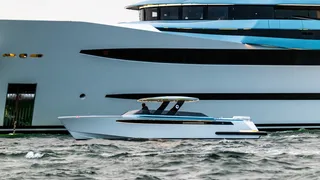A superyacht is only as versatile as the tender that supports it. Discover everything you need to know about yacht tenders – what they are, why they matter and how to choose the perfect tender for leisure, watersports, guest transport and more. From luxury limousine tenders to rugged RIBs, BOAT’s guide covers it all.
What is a superyacht tender?
A superyacht tender is a smaller support vessel that acts as a multifunctional extension of the main yacht (also known as the "mothership"). From ferrying guests ashore to supporting watersports and serving as a vital safety tool, tenders are a cornerstone of the modern superyacht lifestyle.
Why is a tender called a tender?
The term tender comes from the verb "to tend”, meaning to serve or attend to. In yachting terms, a tender is a vessel that tends to the needs of the superyacht. This support role includes logistics, leisure and transport - hence the name.
Will I need a tender?
In short: yes. Whether you're running a 30-metre yacht or a 100-metre explorer, tenders are non-negotiable. They allow access to shallow anchorages, provide discreet guest transport and support a wide range of recreational activities.
If your yacht spends time at anchor, moored offshore or explores remote destinations, a tender is vital.
How to choose a superyacht tender
When selecting a tender, several factors come into play. The goal is to strike a balance between functionality, storage, performance and aesthetics.
1. Purpose: What will you use it for?
Before choosing a tender, define its primary role. Common uses include:
Leisure
A leisure tender often features plush seating, a sunshade and a stable ride for guest comfort. These are perfect for day trips, beach drop-offs and scenic coastal cruising.
Watersports
For thrill-seekers, a dedicated watersports tender, such as a RIB (Rigid Inflatable Boat) or jet tender, comes equipped with high-performance engines and towing capabilities for water skiing, wakeboarding or inflatables.
Guest transport
VIP guest shuttles require a higher level of finish, weather protection (e.g. retractable canopies), and sometimes even climate control. A popular option is the limousine tender – aptly named for its fully enclosed cabin that mirrors the comfort and elegance of a luxury limousine.
Crew or safety boat
A practical, no-frills tender focused on functionality. Used for provisioning and as an emergency escape or rescue boat. Durability and easy maintenance are key here.
Maritime regulations state that any yacht with an internal volume exceeding 500GT must carry a SOLAS-compliant rescue tender (SOLAS stands for ‘Safety of Life At Sea’). These specially equipped boats are designed for man overboard recovery and to support life rafts in the event of an emergency evacuation from the mothership.
2. Tender storage and deployment
Where and how your tender is stored play a major role in your selection. Consider:
- Garage dimensions: Can it be stowed in an onboard tender garage?
- Davits or cranes: How is it launched and recovered?
- Deck space: Does it interfere with other equipment or toys?
3. Size and capacity
The tender’s size must be proportionate to the mothership and its guest/crew capacity. Typical lengths range from four to 10 metres, but custom builds can go far beyond. Consider how many passengers you need to carry, the maximum beam you can accommodate on the mothership and if there is a draught restriction.
4. Build and performance
Beyond looks and layout, a tender’s build quality and technical performance are critical to its reliability, safety and overall guest experience. From hull construction to propulsion systems, these core specifications will determine how well your tender performs in real-world conditions. Here's what to consider:
- Hull type: RIBs offer stability and shock absorption; hard-hull tenders deliver speed and luxury.
- Fuel type: Petrol, diesel or electric? Each has pros and cons based on range, emissions and yacht integration.
- Speed and range: Will you be making long transfers or need high speeds for water sports?
5. Design and branding
Tenders can be highly personalised extensions of the mothership. Owners and designers are increasingly seeking custom builds that mirror the yacht’s styling, materials and colour palette. Some common design options include:
- Monohull or catamaran
- Centre versus side console positioning ('console' meaning helm station)
- Drop-down bow steps for easy boarding and disembarking on beach landings
- Stern swim platform
- Retractable sun canopies and Biminis
- Upholstery and hull colours to match the mothership’s design scheme
- Climate control systems
- Underwater lights
- High-end sound systems
6. Builder and support
Choose a tender manufacturer with a proven track record in the superyacht industry. Look for:
- Global service and support
- Proven performance history
- Easy access to spare parts
- Customisation options
Trusted names include Pascoe International, Compass Tenders, Williams Jet Tenders, Novurania of America, Ribeye, Castoldi and Extender, among others.
Is one tender enough?
Larger yachts often carry multiple tenders, each tailored to a specific purpose. A common combo includes:
- One VIP limousine tender
- One watersports/high-performance tender
- One crew/rescue tender
This setup ensures flexibility and redundancy and is vital for remote cruising or charter operations.
Choosing the right superyacht tender is an investment in versatility, safety and enjoyment. By considering all the factors – from storage and performance to aesthetics and brand – you ensure every transfer, water sport session and shore excursion is done with ease.
For more expert superyacht tips and essential yachting advice, explore our latest yacht advice guides.

